One of the most depressing statements to my ears, is the assertion that a child is too disabled to play. Here the focus
is on the child's inability to manipulate toys when alone or in the company of other children. However this incapacity is
just as true of babies and yet we would not dream of saying they can't play. Indeed adults make strenuous efforts to get babies
playing and their reward at first is simple – the baby's smile.
McConkey, 2006
All children have a right to play. The United Nations Convention on the Rights of the Child (article 31) recognises 'the right of the child to rest and leisure, to engage in play and recreational activities appropriate to [their] age, and to participate freely in cultural life and the arts.
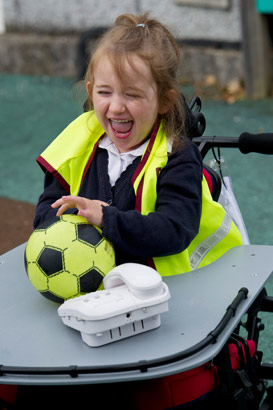
Play is difficult to define, but includes the following characteristics. It is:
- Not reliant on materials, activities or contexts;
- Internally motivated;
- Voluntary;
- Focused on the process rather than an end product;
- Flexible and spontaneous;
- Free from the constraints of reality;
- Pleasurable.
During play, the child is in control, and actively engaged in the play.
(Luckett et al, 2007)
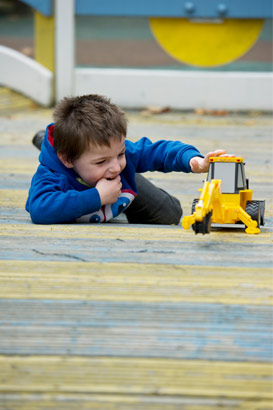
Researchers have found that, compared with typically developing children, the play of children with developmental delay is likely to:
- Reflect children's mental age rather than their chronological age;
- Use immature play strategies (eg more sensorimotor play and less symbolic/pretend play);
- Be limited in imitation, turn-taking and co-operation;
- Be less spontaneous;
- Be more repetitive;
- Be more solitary.
(Lifter et al, 2011)
Play sessions facilitated social development as Stuart demonstrated an increased desire to interact socially with staff
for tangible gains [ie play experiences]... Enhanced social skills were conveyed through increased eye-contact, increased
attempts in initiating interactions, closer proximity to others, imitative behaviours, and longer periods of joint attention.
Thornton and Taylor, 2007
Play interventions must be planned and designed to reflect a child's developmental capabilities and needs – being assessment-based, with clear targets and ongoing monitoring. Research suggests that effective play interventions have positive social outcomes (Lifter, 2011), as for this adolescent with autism and severe learning disabilities:
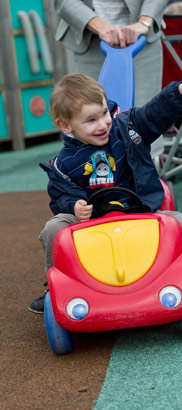
Developmentally, play opportunities should reflect or slightly extend what a child can already do (Wilson, 2003); however, when play activities are utilised as a basis for social interaction, they should be ones the child has already mastered (Lifter et al, 2011).
- Planned activities should complement and encourage child-initiated play and interactions with people and objects so they learn actively through experience.
- Responsive teaching provides positive interactions to encourage children's engagement in activities.
- Physical and social environments should invite and reinforce child-initiated play.
- Educators should capitalise on 'teachable moments' arising naturally in unstructured or semi-structured situations.
During play, the child is in control, and actively engaged in the play.
(Wilson, 2003)
attention (1)
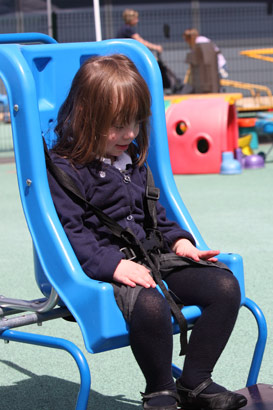
To support the social attention of children with developmental delays, educators should:
- Provide play-related activities to enhance social functioning;
- Pre-teach social skills such as turn-taking, sharing, initiating and verbal responses;
- Adapt teaching practices and the physical and social environments to enhance social opportunities;
- Plan interventions and set realistic goals based on observation of children's patterns of behaviours and attention.
(Bortoli and Brown, 2008)
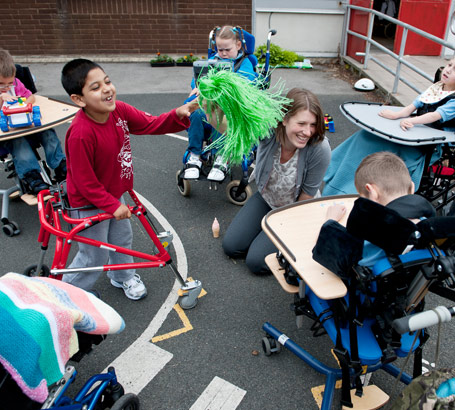
Based on your reading about play and children with learning disabilities, identify how informal play opportunities and a play intervention could be used to support the social development of a young person you work with taking account of their capabilities and needs. Together with therapists (eg speech and language, physio, occupational) and educational psychologists working with the young person, discuss how this could be designed and implemented.

Corke, M. (2011) Using Playful Practice to Communicate with Special Children. London: David Fulton.
Hine, T. and Woollery, M. (2006) Using point-of-view video modeling to teach play to preschoolers with autism, Topics in Early Childhood Special Education, 26 (2), 83-93.